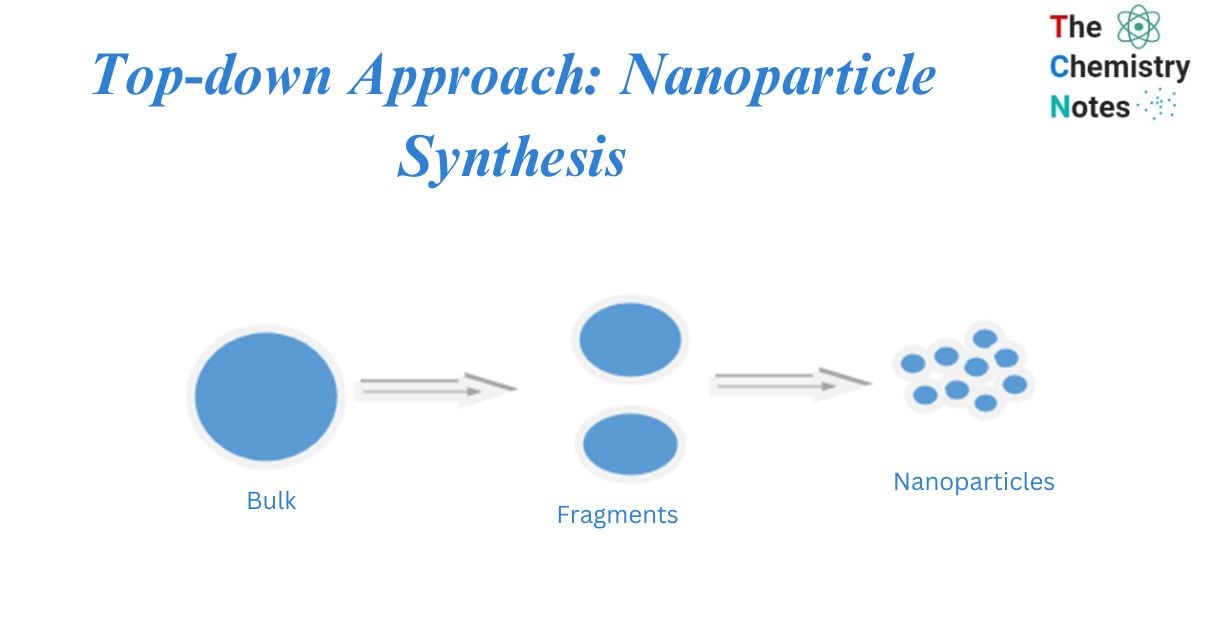
The top-down approach begins with macroscopic structures. The processes begin with bigger particles that are converted to nanoparticles through a series of activities. The main disadvantages of these systems are that they require huge installations and a large amount of capital to set up. The Top-down approach is highly costly and unsuitable for mass production. The procedure is ideal for laboratory testing. The approach is based on material grinding. These approaches are unsuccessful for soft material. A top-down approach is a destructive approach of reducing a bulk material to nanometric-size particles. Top-down approach frequently employs externally controlled tools to cut, grind, and shape materials into nanoscale structures.

Some of the most common nanoparticle synthesis processes are mechanical milling, nanolithography, laser ablation, sputtering, and thermal breakdown.
Interesting Science Videos
Different Methods of Top-down Approach
Mechanical milling
Mechanical milling is the most widely utilized method for producing different nanoparticles. Mechanical milling is used for milling and post-annealing of nanoparticles during synthesis when different components are milled in an inert atmosphere. Mechanical synthesis can produce a wide range of nanocomposite materials, including spray coatings that are resistant to wear, nanoalloys based on aluminum, nickel, magnesium, and copper, and aluminum alloys that have been strengthened by oxide and carbide.
Nanolithography
The study of manufacturing nanometric scale structures with a minimum of one dimension in the size range of 1 to 100 nm is known as nanolithography. Nanolithographic processes include optical, electron-beam, multiphoton, nanoimprint, and scanning probe lithography. The primary advantage of nanolithography is the ability to generate anything from a single nanoparticle to a cluster with the desired form and size. The downsides are the need for complex equipment and the accompanying costs.
Lithography, which uses a focussed beam of light or electrons, is a valuable technology for building nanoarchitectures. There are two forms of lithography: masked lithography and maskless lithography. Using a specified mask or template, nanopatterns are transmitted over a vast surface area in masked nanolithography. Variable nanopattern writing is done without the use of a mask in maskless lithography.
Arc Discharge method
During the Arc Discharge method, two graphite rods are adjusted in a chamber with continuous helium pressure. It is critical to fill the chamber with helium because oxygen or moisture hinders fullerene production. Carbon rods vaporize as a result of an arc discharge that occurs between the ends of the graphite rods. The circumstances under which arc discharge occurs have significant effects on the ability to create new forms of nanoparticles.
Electrospinning
It is commonly used to make nanofibers out of numerous materials, most notably polymers. Coaxial electrospinning was a significant development in electrospinning. The spinneret in coaxial electrospinning is made up of two coaxial capillaries. Two viscous liquids, or a viscous liquid as the shell and a non-viscous liquid as the core, can be employed in these capillaries to build core-shell nanoarchitectures in an electric field. Coaxial electrospinning is an efficient and straightforward top-down method for producing core-shell ultrathin fibers on a large scale.
Sputtering
Sputtering is a technique to generate nanomaterials that involves hitting solid surfaces with high-energy particles such as plasma or gas. Sputtering is believed to be an efficient process for creating thin films of nanomaterials. A sputtering deposition involves the bombardment of the target surface with energetic gaseous ions, which causes the physical ejection of tiny atom clusters dependent on the incident gaseous-ion energy.
Sputtering is the process of depositing nanoparticles on a surface by ejecting particles from it when they collide with ions. Sputtering is typically characterized by the deposition of a thin layer of nanoparticles followed by annealing. The form and size of the nanoparticles are determined by the thickness of the layer, the temperature and length of annealing, the substrate type, and other factors.
Laser ablation
Laser ablation synthesis generates nanoparticles by striking the target material with a strong laser beam. Because of the high energy of laser irradiation, the source material or precursor vaporizes during the laser ablation process, resulting in nanoparticle production. Since no stabilizing agents or other chemicals are required, using laser ablation to generate noble metal nanoparticles can be called a green process. This approach may manufacture a wide variety of nanomaterials, including metal nanoparticles, carbon nanomaterials, oxide composites, and others.
Pulse wire discharge method
This is the most common way of producing metal nanoparticles. A pulsing current causes a metal wire to evaporate, resulting in vapor, which is then cooled by an ambient gas to produce nanoparticles. This strategy has the potential to generate enormous amounts of energy quickly.
Thermal decomposition
Thermal decomposition is an endothermic breakdown of chemicals caused by heat. The temperature at which an element begins to decompose is known as the decomposition temperature. The metal is broken down at particular temperatures in a chemical reaction that yields secondary compounds, creating the nanoparticles.
Electron explosion
A thin metal wire is exposed to a high current pulse in this process, resulting in an explosion, evaporation, and ionization. By reacting with a neighboring gas or liquid media, the metal vaporizes, ionizes, expands, and cools. Finally, the nanoparticles are formed by the condensed vapor.
Sonication
Sonication is the most important stage in the production of nanofluids. After magnetic stirring in a magnetic stirrer, the mixture is sonicated in an ultrasonication path, ultrasonic vibrator, and mechanical homogenizer. Nanomaterials including carbon nanotubes, graphene, inks, metal oxides, etc. can be processed using probe sonication.
Advantages of Top-down Approach
- Large-scale production: The Top-down Approach process allows for deposition across a large substrate. • Chemical purification is not required.
Disadvantages of Top-down Approach
- Nanoparticle size varies (10-1000 nm).
- Various particle forms and geometry are conceivable.
- Controlling deposition parameters is tough during Top-down Approach.
- In Top-down Approach impurities: Stress, flaws, and imperfections are introduced.
References
- https://iopscience.iop.org/article/10.1088/1757-899X/263/3/032019/pdf
- https://www.frontiersin.org/articles/10.3389/fmicb.2023.1155622/full
- https://pubs.rsc.org/en/content/articlehtml/2021/ma/d0ma00807a.
- https://journals.innovareacademics.in/index.php/ijcpr/article/view/41556/24630
